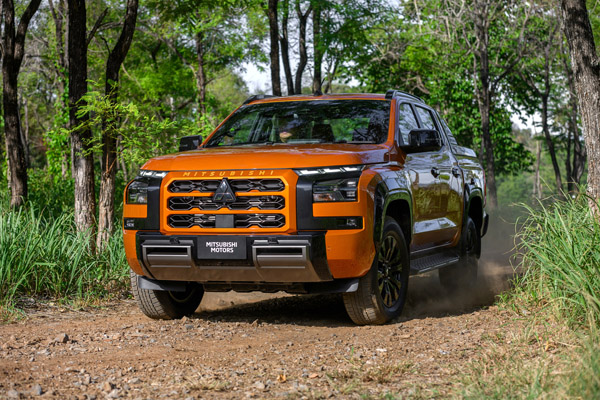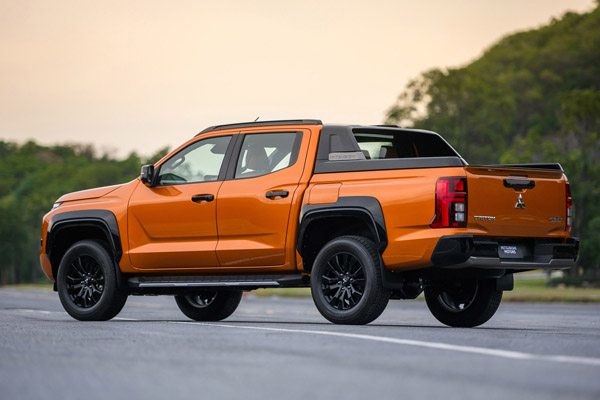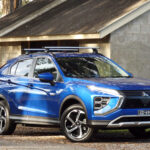
Mitsubishi’s new Triton has broken cover in Thailand, a model crucial to the
company’s future growth.
Larger than before, the sixth generation Triton has been completely redesigned for
the first time in nine years.
It sits on a newly developed ladder frame that provides durability and reliability, with
a newly developed engine that achieves both higher output and improved
environmental performance.
The newly developed 4N16 2.4-litre clean diesel comes in three different output
specifications to meet different purposes:
The high-output version is equipped with a new turbo charger and new combustion
system, providing a flat maximum output of 150kW of power and 470Nm of torque
from around 1500 rpm, enabling highly-responsive driving with abundant torque in
the range of practical use.
There are two versions of the standard specification, 135kW and 430Nm — the other
with 110kW/330Nm. The current Triton produces 133kW and 430Nm from a 2.4-litre
diesel.
All-new Triton comes with either a six-speed auto with Sports mode from the
previous model, or a six-speed manual transmission with shift-by-wire that reduces
vibration directly transmitted from the engine and improving comfort.
The four-wheel drive system is the same Super Select 4WD-II and Easy Select 4WD
systems.
Super Select 4WD-II is equipped with a centre torque sensing Limited Slip
Differential (LSD) that distributes driving force at a ratio of 40:60 front and rear,
ensuring traction and cornering performance.

Models equipped with the Super Select 4WD-II system can select from the four
options of 2H (rear-wheel drive), 4H (full-time four-wheel drive), 4HLc (locked centre
differential) and 4LLc (locked centre differential with lower gears), with seven drive
modes including on-road modes, an increase over the four off-road modes of the
previous model.
Along with Normal mode that is available in all four-wheel drive modes, 2H offers
Eco mode for prioritisation of economy, 4H offers Gravel and Snow modes, 4HLc
offers Mud and Sand modes for traction performance, while 4LLc provides Rock
mode, allowing drivers to select the optimum drive mode for any road condition.
The 4WD modes available for selection in vehicles equipped with Easy Select 4WD
are 2H (rear-wheel drive), 4H (locked centre differential), and 4L (for low-gear
driving).
AYC is newly adopted for models equipped with the Super Select 4WD-II system.
It improves cornering performance by applying light braking to the inside front wheel
when cornering.
Both the two-wheel and four-wheel drive models are equipped with active LSD
(brake control type).
By applying the brake to a spinning wheel and distributing the driving torque to
wheels gripping the road surface, it improves safety on slippery surfaces.
The cargo bed height has been lowered 45mm and the upper surface area of the
bumper corner has been enlarged and reinforced with a frame to be used as a step.
All-new Triton comes in three body styles – double-cab, club cab and single cab.
Inside, the hip point has been raised 20mm and an upright posture has been
adopted to improve visibility from inside the vehicle.

In addition, ingress and egress have been made easier with A-pillars that are more
vertical to widen door openings and widen the side steps, reducing the risk of
slipping.
The touchscreen is now freestanding and while the instrument cluster shows a more
advanced info panel, the major dials remain analogue.
All-new Triton also adds Adaptive Cruise Control (ACC) that tracks acceleration,
deceleration, and stopping of the vehicle in front, and cruises while maintaining a
preset distance between vehicles.
Advanced safety features have been enhanced along with the retention of Forward
Collision Mitigation system (FCM), Blind Spot Warning (BSW) with Lane Change
Assist (LCA), and Rear Cross Traffic Alert (RCTA) among others.
Bottom line? Despite a raft of improvements, Mitsubishi hasn’t really taken the
opportunity to advance the genre.
Triton still comes with a diesel engine, the dash is half-baked and the rear brakes are
still drums.
Be that as it may, the very colourful all-new Triton is due to arrive in Australia in the
first three months of 2024.
A jump in price would be a big mistake.











